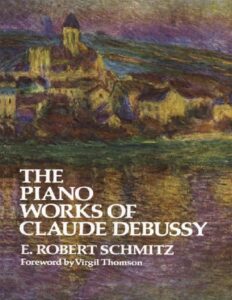Browse in the Library:
Or browse in the categories menus & download the Library Catalog PDF:
Debussy plays Debussy – Clair de Lune (1913)

Claude-Achille Debussy – Clair de Lune (Mondglanz, Mondschein, Moonlight), Suite Bergamasque, Debussy, piano.
The Suite bergamasque was first composed in 1890-1905. “Claude Debussy Plays His Finest Works” Claude Debussy, Piano Roll, 1913.
From 1903 to 1913, Claude Debussy recorded several of his own pieces on piano rolls. Debussy was delighted with the reproduction quality, saying in a letter to Edwin Welte: “It is impossible to attain a greater perfection of reproduction than that of the Welte apparatus. I am happy to assure you in these lines of my astonishment and admiration of what I heard. I am, Dear Sir, Yours Faithfully, Claude Debussy.”
More than one century old, these recordings allow us to listen to the great composer playing his own works. Debussy made his last recordings when he was 52 years old and suffering from cancer, in 1913. He died less than five years later, on March 25, 1918.
Rolls for the reproducing piano were generally made from the recorded performances of famous musicians. Typically, a pianist would sit at a specially designed recording piano, and the pitch and duration of any notes played would be either marked or perforated on a blank roll, together with the duration of the sustaining and soft pedal.
Reproducing pianos can also re-create the dynamics of a pianist’s performance by means of specially encoded control perforations placed towards the edges of a music roll, but this coding was never recorded automatically.
Different companies had different ways of notating dynamics, some technically advanced (though not necessarily more effective), some secret, and some dependent entirely on a recording producer’s handwritten notes, but in all cases these dynamic hieroglyphics had to be skillfully converted into the specialized perforated codes needed by the different types of instrument.
The playing of many pianists and composers is preserved on reproducing piano roll. Gustav Mahler, Camille Saint-Saëns, Edvard Grieg, Teresa Carreño, Claude Debussy, Manuel de Falla, Scott Joplin, Sergei Rachmaninoff, Sergei Prokofiev, Alexander Scriabin, Jelly Roll Morton and George Gershwin are amongst the composers and pianists who have had their performances recorded in this way.
Claude Debussy’s famous Clair de lune is the third piece of the Suite bergamasque for piano, a work whose title was chosen as much for its composer’s love of the word-sounds as for its Renaissance implications (though the work can rightly be described as something of a tribute to the French harpsichordists of olden days).
The D flat major of Clair de lune is perfectly chosen, the gleaming melody in parallel thirds (con sordina, Debussy requests) expertly balanced by the beautifully dissonant tempo rubato that follows it. During the un poco mosso middle section of Clair de lune, the music swells far past the pianissimo of the opening, and in its climax one might say that the young composer has crafted more of sunlight than of moonlight; the incessant arpeggios may well be overdone, but one can cherish them all the same.
Little wisps of these arpeggios find their way over into the reprise of the opening music, and the rolling tones of the middle section are given a few measures to plead their case once more before the final chromatic cadence, a moment of absolute tranquility, is made.
Clair de Lune is a French poem written by Paul Verlaine in the year 1869. It is the inspiration for the third and most famous movement of Debussy’s 1890 Suite bergamasque of the same name. ‘Clair de lune’ (‘Moonlight’) is from Verlaine’s early collection Fêtes galantes (Gallant Parties, 1869).
Clair de Lune by Paul Verlaine
“Clair de lune” (English “Moonlight”) is a poem written by French poet Paul Verlaine in 1869. It is the inspiration for the third and most famous movement of Claude Debussy‘s 1890 Suite bergamasque. Debussy also made two settings of the poem for voice and piano accompaniment. The poem has also been set to music by Gabriel Fauré, Louis Vierne and Josef Szulc.
Votre âme est un paysage choisi
Que vont charmant masques et bergamasques
Jouant du luth et dansant et quasi
Tristes sous leurs déguisements fantasques.
Tout en chantant sur le mode mineur
L’amour vainqueur et la vie opportune
Ils n’ont pas l’air de croire à leur bonheur
Et leur chanson se mêle au clair de lune,
Au calme clair de lune triste et beau,
Qui fait rêver les oiseaux dans les arbres
Et sangloter d’extase les jets d’eau,
Les grands jets d’eau sveltes parmi les marbres.
Your soul is a chosen landscape
Where charming masquerades and dancers are promenading,
Playing the lute and dancing, and almost
Sad beneath their fantastic disguises.
While singing in a minor key
Of victorious love, and the pleasant life
They seem not to believe in their own happiness
And their song blends with the light of the moon,
With the sad and beautiful light of the moon,
Which sets the birds in the trees dreaming,
And makes the fountains sob with ecstasy,
The slender water streams among the marble statues.
Browse in the Library:
Or browse in the categories menus & download the Library Catalog PDF:
